Somalia, officially the Federal Republic of Somalia and formerly known as the Somali Democratic Republic, is a country located in the Horn of Africa. The country was an important centre for commerce with the rest of the ancient world, and according to most scholars, it is among the most probable locations of the fabled ancient Land of Punt. During the Middle Ages, several powerful Somali states and port towns dominated the regional trade, the Mogadishu Sultanate and Ajuran Sultanate both centered around the port town Mogadishu, but also the port towns of Barawe and Merca.
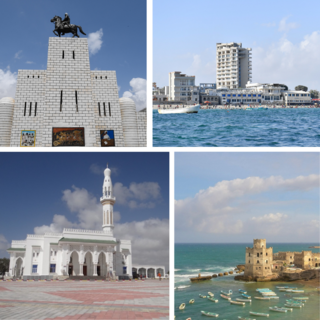
Mogadishu, locally known as Xamar or Hamar, is the capital and most populous city of Somalia. The city has served as an important port connecting traders across the Indian Ocean for millennia, and has an estimated urban population of 6,610,483. Mogadishu is located in the coastal Banadir region on the Indian Ocean, which unlike other Somali regions, is considered a municipality rather than a maamul goboleed.

Italian Somaliland was a protectorate and later colony of the Kingdom of Italy in present-day Somalia. Ruled in the 19th century by the Somali Sultanates of Hobyo and Majeerteen in the north, and in the south the Hiraab Imamate and Geledi Sultanate. The territory was acquired in the 1880s by Italy through various treaties.

The Catholic Church in Somalia is part of the worldwide Catholic Church, under the spiritual leadership of the Pope in Rome.
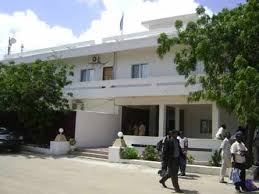
Villa Somalia is a building in Mogadishu, the capital of Somalia. It serves as the palace and principal workplace of the president of Somalia. The current president is Hassan Sheikh Mohamud (HSM).

Christianity is a minority religion in Muslim-majority Somalia, with an estimated 1,000 practitioners in a population of over 17 million inhabitants. Although early Christian Orthodoxy was practised by ethnic Somalis prior to Islam, most modern-day Christian adherents come from the Bantu ethnic minority group, or are descended from Italian colonists and belong to the Evangelical and Wesleyan Church of the Nazarene. There is one Catholic diocese for the entire country, the Diocese of Mogadishu.

The Trust Territory of Somaliland, officially the "Trust Territory of Somaliland under Italian administration", was a United Nations Trust Territory situated in present-day Somalia. Its capital was Mogadishu and was administered by Italy from 1950 to 1960, following the dissolution of the former British Military Administration. It gained independence in 1960.

Italian Somalis are Somali-born citizens who are fully or partially of Italian descent, whose ancestors were Italians who emigrated to Somalia during the Italian diaspora, or Italian-born people in Somalia. Most of the Italians moved to Somalia during the Italian colonial period.
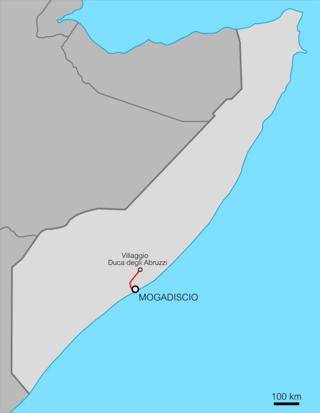
The Mogadiscio–Villabruzzi Railway is an historical railway system that ran through southern Somalia. It was constructed between 1914 and 1927 by the colonial authorities in Italian Somaliland. The railway connected the capital city Mogadishu with Afgooye, and subsequently with Villaggio Duca degli Abruzzi – usually called "Villabruzzi". The line was later dismantled by British troops during World War II. Plans for re-establishing the railway were made in the 1980s by the Siad Barre administration, but were aborted after the regime's collapse.

Railway transport in Somalia consisted of the erstwhile Mogadishu–Villabruzzi Railway and secondary tracks. The system was built during the 1910s by the authorities in Italian Somaliland. Its track gauge was 950 mm, a gauge favoured by the Italians in their colonies in the Horn of Africa and North Africa. The railway was dismantled in the 1940s by the British during their military occupation of Italian Somaliland, and was subsequently never rehabilitated.

Somali architecture is the engineering and designing of multiple different construction types such as stone cities, castles, citadels, fortresses, mosques, temples, aqueducts, lighthouses, towers and tombs during the ancient, medieval and early modern periods in Somalia and other regions inhabited by Somalis, as well as the fusion of Somalo-Islamic architecture with Western designs in contemporary times.

The Eng. Yariisow Stadium, formerly known as Garoonka Banaadir Stadium, or simply Benadir Stadium in the Somali language, is a multi-use 20,000-capacity stadium in Mogadishu, Banaadir, Somalia, that is currently used mostly for football matches. Until the 1970s, the stadium was called the Coni Stadium because it was built by the Italian Coni. It is currently being rebuilt through FIFA's Win in Africa with Africa program.
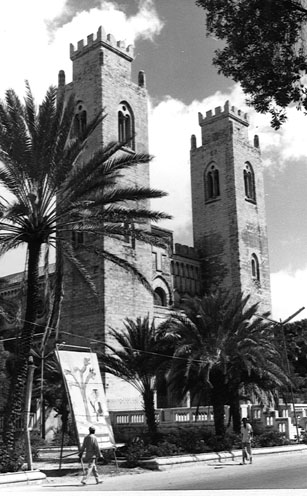
Mogadishu Cathedral is a ruined Roman Catholic cathedral located in Mogadishu, Somalia. Between 1928 and 1991, it served as the seat of the Roman Catholic Diocese of Mogadiscio. Built in 1928 by Italian colonial authorities, much of the building was destroyed in 2008 by al-Shabaab. In 2013, the diocese announced plans to refurbish the building.

Football in Somalia is run by the Somali Football Federation. The association administers the national football team, as well as the Premier League. Football is the most popular sport in Somalia.

The National Museum of Somalia is a national museum in Mogadishu, the capital of Somalia. It was established in 1933 by the colonial authorities in Italian Somaliland. After shutting down operations in 1991, it later reopened, and presently houses a number of important historical artefacts. In September 2019, the museum was rebuilt; almost 30 years after its destruction.
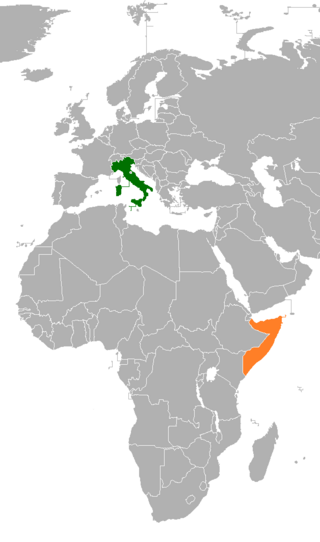
Italy–Somalia relations are bilateral relations between Italy and Somalia.

All railway stations in Italian Somaliland were served by the Mogadishu–Villabruzzi Railway of 114 kilometres (71 mi).

The Port of Mogadishu, also known as the Mogadishu International Port, is the official seaport of Mogadishu, the capital of Somalia. Classified as a major class port, it is the largest harbour in the country.

The Mogadiscio Circuit was formerly a car race through the main streets of Mogadiscio, Italian Somaliland, being first run in 1938.

The Petrella Airport was the first international airport in Italian Somalia. It was opened in 1928 -just 3 miles south of Mogadishu- with the name "Enrico Petrella" in honor of an Italian pilot who died a few years before in the same airport of Italian Mogadiscio. In 1941 the airport was partially destroyed during WW2 and remained inactive for some years as a civilian airport: only military airplanes used it. In 1950 was reopened as a civilian airport by the Italian authorities of the ONU Fiduciary Mandate.



















